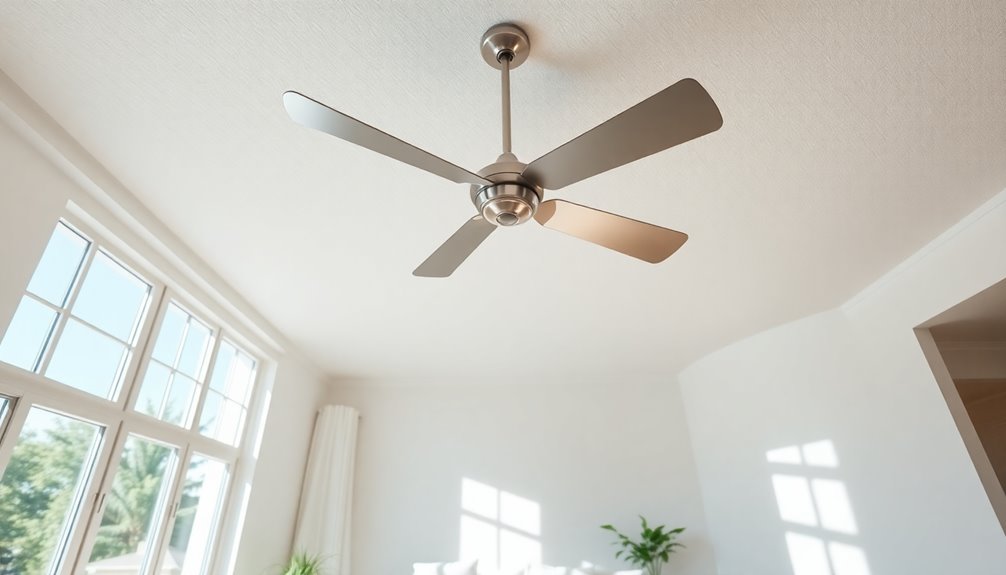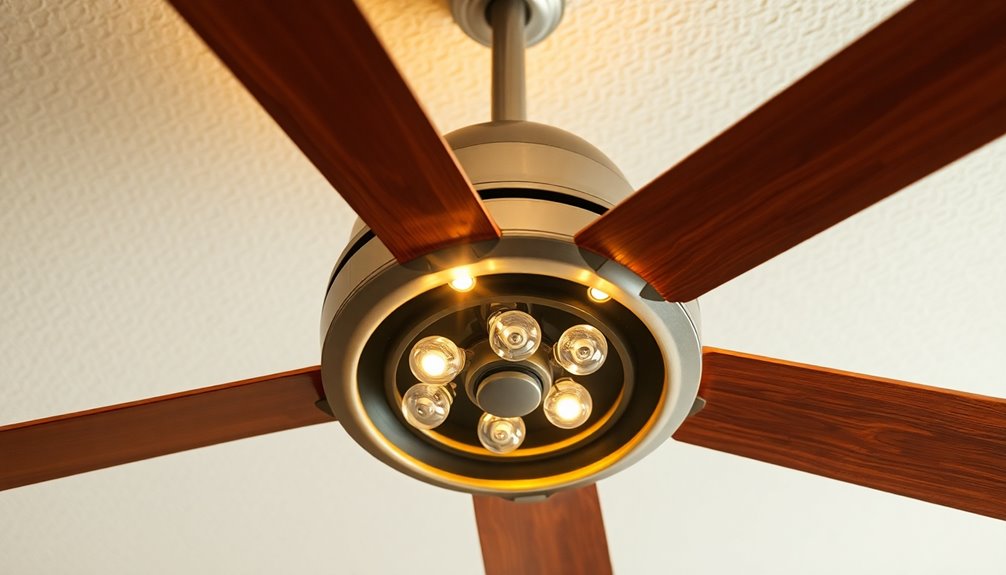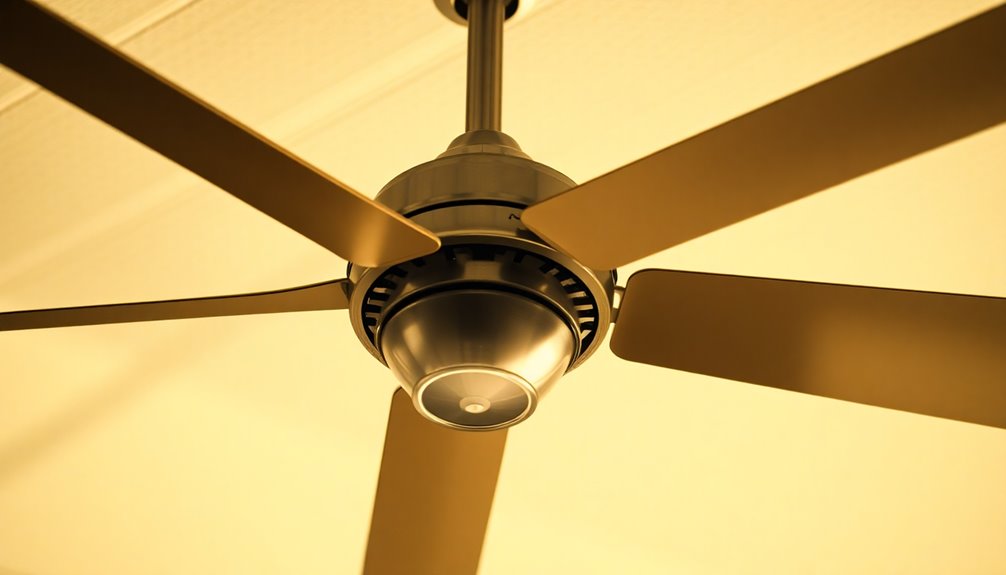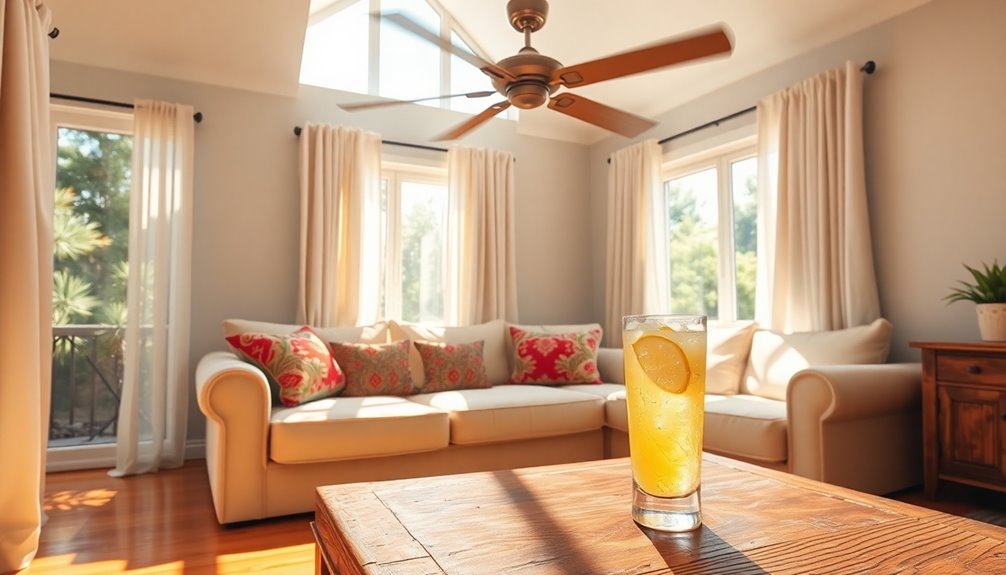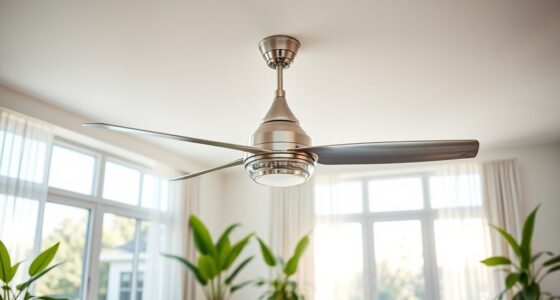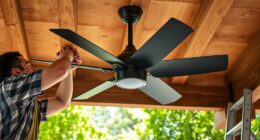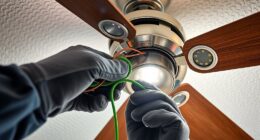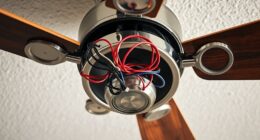In the summer, you should always set your ceiling fan to turn counterclockwise. This direction pushes cooler air down, creating a revitalizing downdraft that makes the room feel about 4 degrees cooler. The counterclockwise rotation not only enhances comfort but can also help reduce your reliance on air conditioning, saving you energy and cost. It's easy to change the direction using a switch on your fan, so adjust it regularly to match the season. If you're curious about more tips on optimizing your ceiling fan's performance and comfort, there's plenty more to explore!
Key Takeaways
- In the summer, a ceiling fan should rotate counterclockwise to create a cooling downdraft.
- Counterclockwise rotation enhances airflow, making rooms feel about 4 degrees cooler.
- Proper fan direction allows for higher thermostat settings without sacrificing comfort.
- Most ceiling fans have a switch to easily change direction for seasonal adjustments.
- Regularly verify fan direction by feeling airflow directly underneath the fan.
Importance of Ceiling Fan Direction

The direction of your ceiling fan plays an essential role in maintaining comfort and managing energy costs in your home.
When you set your fan to rotate counterclockwise during summer, it creates a cooling downdraft that enhances airflow and makes your space feel cooler. This simple adjustment can considerably impact your comfort level and help you save on energy bills.
By ensuring your ceiling fan direction is correct, you can raise your thermostat settings by about 4 degrees without sacrificing comfort. This means you can rely less on air conditioning, potentially lowering your energy costs by up to 30%.
If your fan runs in the wrong direction, you might experience inadequate airflow, leading to discomfort and higher energy consumption.
Summer Fan Settings

To keep cool in the summer, you need to set your ceiling fan to spin counterclockwise.
This rotation not only creates a revitalizing downdraft but can also help you save on energy costs by allowing you to raise your thermostat.
Let's explore how these simple adjustments can make a big difference in your comfort and bills.
Counterclockwise Rotation Benefits
When summer heat sets in, adjusting your ceiling fan to rotate counterclockwise can make a significant difference in comfort. This rotation creates a cooling downdraft that pushes cooler air downward, generating a revitalizing breeze in your space.
You'll feel the wind chill effect, making the room feel about 4 degrees cooler without actually lowering the air temperature.
By using your ceiling fan in the counterclockwise direction, you can also reduce your reliance on air conditioning. This simple adjustment could potentially save you up to 30% on cooling costs, making your summer more enjoyable and budget-friendly.
To achieve ideal cooling efficiency, verify your fan blades are angled at least 12 degrees. This angle maximizes airflow and enhances the cooling effect.
To confirm the fan is rotating counterclockwise, stand directly underneath it and feel the cool breeze created by the downward airflow. If you feel that invigorating draft, you're all set for a comfortable summer experience. Additionally, staying cool with a ceiling fan can help reduce energy consumption and lower your overall utility bills.
Energy Savings Impact
Adjusting your ceiling fan to rotate counterclockwise not only enhances comfort but also considerably impacts your energy savings during the summer months.
This ceiling fan direction creates a cooling downdraft that can make you feel notably cooler, allowing you to raise your thermostat settings by about 4 degrees. With this simple adjustment, you can reduce your air conditioning costs considerably.
Running a ceiling fan consumes only about 50 watts of energy, while air conditioning units typically use around 3,500 watts.
By using your ceiling fan in conjunction with an ENERGY STAR certified air conditioning system, you can boost overall efficiency by up to 8%. This means your ceiling fan can effectively reduce energy consumption and costs.
When you properly adjust your fan's direction for summer, you could see energy cost reductions of up to 30%. Additionally, using heat pumps can further enhance your home's overall energy efficiency and reduce reliance on traditional air conditioning systems.
Not only does this help your wallet, but it also contributes to a more comfortable living environment.
Energy Savings With Fans

Using a ceiling fan in the summer can lead to significant energy savings while keeping you comfortable. When your ceiling fan rotates counterclockwise, it creates a cooling downdraft, making the room feel up to 4 degrees cooler. This effect can help reduce your reliance on air conditioning, potentially saving you up to 30% on your energy costs.
Ceiling fans consume about 50 watts of energy, which is a fraction compared to the 3,500 watts used by typical air conditioning units. By using a ceiling fan alongside an ENERGY STAR-rated air conditioner, you can enhance cooling efficiency by up to 8%.
Properly adjusting the ceiling fan direction during summer not only improves your comfort but also contributes to overall energy savings and lower utility bills. Additionally, utilizing energy-efficient technology can further enhance your energy savings and comfort level.
You'll enjoy a cooler environment without cranking up the AC, benefiting both your wallet and the planet. So, remember to set your ceiling fan to the right direction this summer, and enjoy the combined benefits of cooling and heating efficiency.
Embracing this simple adjustment can make a big difference in your energy consumption.
Changing Fan Direction

To keep your space cool in summer, you need to change your ceiling fan's direction to counterclockwise.
This simple adjustment not only enhances your comfort but can also lead to energy savings.
Let's explore how to make this switch efficiently and the benefits it brings.
Summer Rotation Guidelines
During the summer months, it's essential to set your ceiling fan to rotate counterclockwise. This ceiling fan direction creates a cooling downdraft, helping to lower the perceived temperature in your room.
By turning counterclockwise, the fan generates a wind chill effect that pushes cooler air downward, creating that much-desired cool breeze you crave on hot days.
To verify your fan is spinning in the right direction, stand directly under it and feel the airflow moving toward you. If it's not, you can easily change the direction using the switch on the motor.
Most ceiling fans come equipped with this switch, allowing you to adjust the blade rotation from clockwise to counterclockwise for seasonal needs.
Once you've set your fan correctly, you'll notice a significant difference in comfort. This adjustment not only enhances your cooling experience but can also allow you to raise your thermostat settings by about 4 degrees without sacrificing comfort.
Energy Savings Benefits
Setting your ceiling fan to rotate counterclockwise not only enhances comfort but also brings impressive energy savings. By adjusting the fan direction in summer, you create a cooling downdraft that helps lower perceived temperatures in your room. This simple change can greatly reduce your reliance on air conditioning, potentially saving you up to 30% on cooling costs.
Running your ceiling fan at high speed allows you to raise your thermostat settings by about 4 degrees without sacrificing comfort, which translates to even more energy savings. When you pair your ceiling fan with an ENERGY STAR air conditioning unit, you can boost overall efficiency by up to 8%. Additionally, using an air purifier alongside your ceiling fan can further enhance indoor air quality, making your living space more comfortable.
Here are some key benefits of adjusting your ceiling fan's direction:
- Lowers perceived temperature, enhancing comfort.
- Reduces air conditioning use, saving money.
- Allows higher thermostat settings without discomfort.
- Increases efficiency of cooling systems when combined.
- Contributes to lower utility bills over time.
- Regular maintenance of air purifiers can further improve indoor air quality, complementing the cooling effects of your ceiling fan.
Embracing the right ceiling fan turn can lead to considerable energy savings, making a noticeable difference in both comfort and costs. Don't overlook this easy adjustment!
Adjusting Fan Direction
Adjusting the direction of your ceiling fan is a simple yet effective way to enhance your summer comfort. To keep your space cool, you'll want to change the direction of your fan to spin counterclockwise. This rotation creates a revitalizing downdraft, pushing cooler air directly down towards you. Installing smart home technology can further optimize your cooling experience by allowing you to control your fan settings remotely. Additionally, using a ceiling fan can reduce reliance on air conditioning, helping you save on energy costs during the warmer months.
Before you make any adjustments, always turn off the fan and let it come to a complete stop. Most ceiling fans have a ceiling fan switch located on the fan body that allows you to easily change the direction. If your fan has a remote control, you can conveniently adjust the settings without getting up. Additionally, proper heat pump maintenance can ensure that your cooling systems operate at peak efficiency during the summer months.
It's a good idea to change the fan direction during Daylight Savings Time adjustments to align your cooling needs with the seasonal shift. By setting your fan to rotate counterclockwise, you not only boost your comfort but also save on energy costs. Regular maintenance of your cooling systems, such as heat pump efficiency, can further enhance your overall energy savings.
This allows you to set your thermostat higher while still feeling cool, making your space more enjoyable and efficient. So, take a moment to check your fan's direction and enjoy the revitalizing benefits it brings this summer!
Timing for Direction Change

Many homeowners often overlook the importance of timing when it comes to changing their ceiling fan's direction. The ideal times to make this adjustment are during Daylight Savings Time shifts—specifically in spring and fall.
As you spring forward, set your fan to rotate counterclockwise. This ceiling fan direction helps you keep cool as summer approaches. Conversely, when falling back, switch the fan to rotate clockwise to prepare for the cooler winter months.
Here are some tips to remember when you change your ceiling fan:
- Adjust your fan direction twice a year during Daylight Savings Time.
- Confirm your fan size is appropriate for the room for peak performance.
- Regularly changing your fan direction can enhance comfort levels.
- Switching directions can notably reduce energy consumption.
- Keep an eye on room temperature to decide when to change the fan.
Optimal Blade Angle

To maximize your ceiling fan's cooling efficiency, it's vital to pay attention to the blade angle. For ideal cooling, set your fan's blades at a minimum of 12 degrees. This angle is critical for creating adequate airflow during the hot summer months.
If you tilt the blades beyond 16 degrees, you might create air turbulence that can disrupt loose objects in the room, which isn't ideal for your comfort.
When you confirm your ceiling fan is rotating counterclockwise, the proper blade angle will enhance airflow and greatly boost cooling efficiency.
If you're in a larger space—over 500 square feet—consider using multiple ceiling fans to maintain consistent airflow and cooling comfort throughout the area.
Additionally, a well-maintained fan with the correct blade angle can help reduce your reliance on air conditioning, leading to energy savings during those sweltering days.
Winter Fan Settings

Using your ceiling fan effectively in winter can make a significant difference in your home's comfort and energy efficiency. To enhance warmth, verify your ceiling fans turn clockwise at medium or low speed. This clockwise direction creates a gentle updraft that redistributes warm air trapped near the ceiling, maintaining a consistent room temperature.
By doing this, you can lower your thermostat settings and potentially save on heating bills by up to 15%. Additionally, utilizing a ceiling fan in this manner can complement your heating efficiency and help maintain an even temperature throughout your home.
Here are some tips to maximize your winter fan settings:
- Set your fan to run clockwise to push warm air down.
- Keep the fan on low speed to avoid drafts.
- For dining rooms, use medium or low speed to keep food warm.
- If you have vaulted ceilings, maintain a counterclockwise setting year-round to reduce wind chill effects.
- Regularly check that your fan is clean for peak performance.
Specific Room Considerations

When it comes to ceiling fan settings, each room has its own needs.
In your dining room, a medium counterclockwise speed keeps you cool without letting your food chill too fast.
For home offices and spaces with vaulted ceilings, adjust your fan to guarantee comfort and effective airflow throughout the summer.
Vaulted Ceiling Fan Usage
Although vaulted ceilings create an appealing aesthetic, they also require specific considerations for ceiling fan usage, especially in summer. To maximize comfort in these spacious areas, you should verify your ceiling fan rotates counterclockwise. This creates a cooling downdraft that effectively pushes cooler air downwards, lowering the perceived temperature in the room.
Here are some tips to enhance your experience:
- Choose the right fan size: Confirm your ceiling fan is properly sized for the vaulted space.
- Install at the correct height: Keep the fan at least 10 inches from the ceiling for ideal airflow.
- Increase fan speed: Operate your fan at a higher speed to circulate air throughout the larger area.
- Maintain consistent rotation: Keep the fan running counterclockwise year-round to prevent wind chill while enhancing air circulation.
- Monitor comfort levels: Adjust settings as needed to find the perfect balance between fan speed and comfort.
Dining Room Settings
To create a comfortable dining environment during summer, guarantee your ceiling fan rotates counterclockwise. This direction creates a cooling downdraft, enhancing air circulation and improving comfort for you and your guests.
By setting the fan to a higher speed, you'll maintain a consistent temperature in the room, allowing you to set the thermostat higher and save on energy costs.
A counterclockwise rotation promotes a wind chill effect, which helps to keep food fresh and enjoyable without over-relying on air conditioning. However, it's best to set the fan to medium or low speed during meals. You want to avoid cooling your food too quickly, as this can change the dining experience.
Ensuring the proper fan direction and speed can greatly contribute to a pleasant atmosphere while potentially reducing energy expenses by up to 30%. Additionally, using energy-efficient models can further enhance your savings and comfort throughout the summer months.
Home Office Adjustments
Creating an efficient home office environment hinges on the proper use of ceiling fans. In the summer, you should set your ceiling fan to rotate counterclockwise. This creates a cooling downdraft, enhancing airflow and ensuring you enjoy cooler air without directly blasting it on you.
It's a simple adjustment that can make a significant difference in comfort and productivity. Additionally, using your ceiling fan strategically allows you to adjust your thermostat, possibly raising it by about 4 degrees while still feeling comfortable. This can lead to energy savings of up to 30%, reducing your reliance on air conditioning.
If you have a vaulted ceiling, keep the fan on counterclockwise year-round to maintain consistent temperatures without creating a wind chill effect.
Here are some tips to maximize your home office experience:
- Set the fan to counterclockwise for summer cooling.
- Use medium speed to avoid blowing papers around.
- Adjust the thermostat while using the fan.
- Keep the fan on counterclockwise year-round in vaulted spaces.
- Enjoy energy savings and a more comfortable workspace.
Embrace these adjustments for a more efficient home office setup!
General Ceiling Fan Tips

Maximize your comfort and energy savings this summer by properly utilizing your ceiling fan. To create a cooling downdraft, make certain your ceiling fan is set to turn counterclockwise. This setting enhances comfort by producing a wind chill effect, allowing you to raise your thermostat by about 4 degrees without sacrificing comfort.
For ideal airflow and efficiency, verify your ceiling fan is installed with a minimum of 10 inches clearance from the ceiling and 18 inches from the walls. This space is essential for proper air circulation throughout your home.
Don't forget to keep your ceiling fan clean! Regularly dusting the blades and motor improves energy efficiency and helps prevent issues like reduced airflow or a failing motor.
Enhancing Comfort and Efficiency

Often overlooked, the proper use of ceiling fans can greatly enhance your comfort and energy efficiency during the hot summer months.
By setting your ceiling fan to spin counterclockwise, you create a cooling downdraft that produces a revitalizing wind chill effect. This action effectively pushes cooler air down, helping to maintain a consistent temperature in your room while reducing your reliance on air conditioning.
To maximize your comfort and efficiency, consider these tips:
- Verify ceiling fan blades are angled correctly (at least 12 degrees) for ideal airflow.
- Set your thermostat up by about 4 degrees when using the fan to save energy.
- Pair your ceiling fan with an ENERGY STAR-rated air conditioning unit for improved efficiency.
- Regularly clean the fan blades to maintain airflow and performance.
- Use your ceiling fan in conjunction with open windows during cooler evenings for natural ventilation.
Frequently Asked Questions
How Do You Tell if Your Ceiling Fan Is Going Clockwise or Counterclockwise?
To tell if your ceiling fan's going clockwise or counterclockwise, stand directly beneath it and feel for a breeze.
If you feel a downward airflow, it's counterclockwise; if there's no noticeable breeze or it feels like air's being pulled up, it's clockwise.
You can also check the fan blades: if they're moving upward on one side and downward on the other, it's spinning counterclockwise.
Don't forget to check the switch or remote for direction changes!
What Is the Best Fan Direction to Cool a Room?
Think of your ceiling fan as a revitalizing breeze on a hot summer day.
To cool a room effectively, you want it to spin counterclockwise. This direction creates a cooling downdraft, making the air feel cooler and more comfortable.
You'll notice a wind chill effect that can lower your perceived temperature by up to 4 degrees.
What Way Should Fans Spin in Winter?
In winter, you should set your ceiling fan to spin clockwise at a low speed.
This creates a gentle updraft that redistributes warm air trapped near the ceiling, making your space feel cozier. By doing this, you can lower your thermostat settings and potentially save on heating bills by up to 15%.
Remember to check the fan's direction while standing underneath it; you'll feel the warm air circulating downwards for added comfort.
How to Tell Fan Direction?
To tell the fan direction, observe the blades' rotation. If they're moving counterclockwise, you'll feel a cool breeze directly beneath the fan.
Most fans have a switch on the motor that lets you easily change the direction—just make sure the fan's off first. If you're using a remote, press the direction button while the fan's off to switch between clockwise and counterclockwise.
Visualizing clock hands can also help!
Conclusion
As you bask in the warm glow of summer, remember that your ceiling fan can be your coolest ally. With blades spinning counterclockwise, it creates a revitalizing breeze that dances through the room, making sweltering days more bearable. By adjusting your fan's direction, you not only enhance comfort but also save on energy costs. So go ahead, flip that switch, and let the gentle whirl of air wrap around you like a soft summer embrace.
